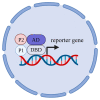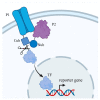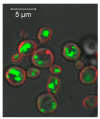Yeast Heterologous Expression Systems for the Study of Plant Membrane Proteins
- PMID: 37445944
- PMCID: PMC10342074
- DOI: 10.3390/ijms241310768
Yeast Heterologous Expression Systems for the Study of Plant Membrane Proteins
Abstract
Researchers are often interested in proteins that are present in cells in small ratios compared to the total amount of proteins. These proteins include transcription factors, hormones and specific membrane proteins. However, sufficient amounts of well-purified protein preparations are required for functional and structural studies of these proteins, including the creation of artificial proteoliposomes and the growth of protein 2D and 3D crystals. This aim can be achieved by the expression of the target protein in a heterologous system. This review describes the applications of yeast heterologous expression systems in studies of plant membrane proteins. An initial brief description introduces the widely used heterologous expression systems of the baker's yeast Saccharomyces cerevisiae and the methylotrophic yeast Pichia pastoris. S. cerevisiae is further considered a convenient model system for functional studies of heterologously expressed proteins, while P. pastoris has the advantage of using these yeast cells as factories for producing large quantities of proteins of interest. The application of both expression systems is described for functional and structural studies of membrane proteins from plants, namely, K+- and Na+-transporters, various ATPases and anion transporters, and other transport proteins.
Keywords: Pichia pastoris; Saccharomyces cerevisiae; baker’s yeasts; heterologous expression; methylotrophic yeasts; plant membrane proteins; recombinant proteins.
Conflict of interest statement
The authors declare no conflict of interest.
Figures







Similar articles
-
Pichia pastoris versus Saccharomyces cerevisiae: a case study on the recombinant production of human granulocyte-macrophage colony-stimulating factor.BMC Res Notes. 2017 Apr 4;10(1):148. doi: 10.1186/s13104-017-2471-6. BMC Res Notes. 2017. PMID: 28376863 Free PMC article.
-
Glycosylation of human alpha 1-antitrypsin in Saccharomyces cerevisiae and methylotrophic yeasts.Yeast. 1998 Mar 15;14(4):371-81. doi: 10.1002/(SICI)1097-0061(19980315)14:4<371::AID-YEA231>3.0.CO;2-1. Yeast. 1998. PMID: 9559545
-
Yeast as a tool for membrane protein production and structure determination.FEMS Yeast Res. 2022 Oct 20;22(1):foac047. doi: 10.1093/femsyr/foac047. FEMS Yeast Res. 2022. PMID: 36175165 Free PMC article.
-
Heterologous protein production in yeast.Antonie Van Leeuwenhoek. 1992 Aug;62(1-2):79-93. doi: 10.1007/BF00584464. Antonie Van Leeuwenhoek. 1992. PMID: 1444338 Review.
-
Which yeast species shall I choose? Saccharomyces cerevisiae versus Pichia pastoris (review).Methods Mol Biol. 2012;866:11-23. doi: 10.1007/978-1-61779-770-5_2. Methods Mol Biol. 2012. PMID: 22454110 Review.
Cited by
-
The Functional Identification of the CYP2E1 Gene in the Kidney of Lepus yarkandensis.Int J Mol Sci. 2025 Jan 8;26(2):453. doi: 10.3390/ijms26020453. Int J Mol Sci. 2025. PMID: 39859169 Free PMC article.
-
Facile expression of proteins with desired N-terminal amino acid via an engineered cysteine protease domain.Commun Biol. 2025 Aug 6;8(1):1165. doi: 10.1038/s42003-025-08614-7. Commun Biol. 2025. PMID: 40770049 Free PMC article.
-
Unlocking the power of antimicrobial peptides: advances in production, optimization, and therapeutics.Front Cell Infect Microbiol. 2025 Apr 28;15:1528583. doi: 10.3389/fcimb.2025.1528583. eCollection 2025. Front Cell Infect Microbiol. 2025. PMID: 40365533 Free PMC article. Review.
-
Genome-wide analysis of KCS family in Medicago reveals MsKCS5's crucial role in abiotic stress adaptation.Plant Cell Rep. 2025 Jul 27;44(8):181. doi: 10.1007/s00299-025-03571-1. Plant Cell Rep. 2025. PMID: 40715510
-
Evaluation of heterologous expression in Pichia pastoris of Pine Weevil TRPA1 by GFP and flow cytometry.Microb Cell Fact. 2024 Apr 12;23(1):110. doi: 10.1186/s12934-024-02382-5. Microb Cell Fact. 2024. PMID: 38609906 Free PMC article.
References
Publication types
MeSH terms
Substances
LinkOut - more resources
Full Text Sources

